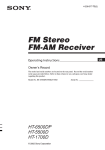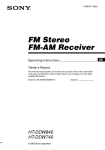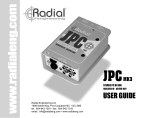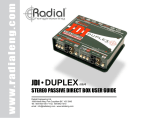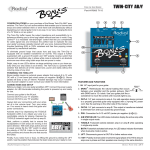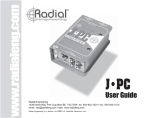Download Radial Engineering PZ-DI User guide
Transcript
www.radialeng.com True to the Music www.radialeng.com PZ-DI ™ Piezo Optimized Active Direct Box Radial Engineering Ltd. 1588 Kebet Way, Port Coquitlam BC V3C 5M5 tel: 604-942-1001 • fax: 604-942-1010 email: [email protected] • www.radialeng.com USER GUIDE ® True to the Music PZ- D I ™ Piezo Optimized Active Direct Box TABLE OF CONTENTS PAGE Introduction ..............................................................................1 Input & output panel features ..................................................2 Overview & load adjustment ....................................................3 Powering the PZ-DI .................................................................4 Connecting the JPC.................................................................5 Using an amplifier ....................................................................6 Using the PAD and low-cut filter ..............................................7 Using the polarity and ground lift .............................................8 Block diagram and specifications ............................................9 Warranty ....................................................................Back cover INTRODUCTION Thank you for purchasing a Radial PZ-DI, one of the most innovative direct boxes ever made! Unlike others that are a ‘one-size-fits-all’ the PZ-DI has been designed from the ground up to solve the problems that are common to piezoelectric transducers while significantly enhancing the musical performance when used with other pickups or instruments. This manual has been written to provide you with a full understanding of how to use the PZ-DI and get the most out of it. Please take a few minutes to read it all the way through. You will find that there are several innovative features built-in that can greatly enhance your enjoyment and the outcome. If by chance you do not find everything you need within these pages, please visit the PZ-DI FAQ page on our web site. This is where we post the latest updates and questions from users like you. If after that you still do not find what you are looking for, feel free to send an email to [email protected] and we will do our very best to reply to you in short order. Now get ready to hear that orchestra like never before! Radial Engineering Ltd. 1 PZ-DI mkII ® 1 True to the Music 2 3 4 5 6 7 8 9 10 11 12 13 INPUT PANEL OUTPUT PANEL 1. INPUT: ¼” hi-Z input used to connect the instrument to the PZ-DI. 8. 2. THRU: ¼” throughput used to feed an on-stage instrument amplifier. NO SLIP PAD: Provides electrical & mechanical isolation while keeping the PZ-DI from sliding around on busy stages. 9. 3. LOAD: 3-position switch lets you adjust the input impedance to optimize the load for the type of pickup being used. Set to 220k ohm for magnetic pickups, 10 meg-ohm for piezo transducers and 1 meg-ohm to replicate traditional DIs. XLR OUT: Balanced low impedance output used to connect the PZ-DI to the mixing console. Allows long cable runs in excess of 100 meters (300 feet) without noise. 4. PAD: Reduces the input sensitivity by -15dB enabling the PZ-DI to be used with high output instruments such as active basses or keyboards. 5. LO-CUT: Variable high-pass filter is used to remove unwanted resonance and size the instrument to suit. Variable from 5Hz to 500Hz. 6. HI-CUT: Used to warm up the sound of active instruments that often contain excessive high frequencies. 7. BOOK-END DESIGN: Creates protective zone around connectors, switches and potentiometers to prevent damage. Radial Engineering Ltd. 10. PHASE: 180° polarity reverse toggles pin-2 and pin-3 at the XLR output. Used to tame acoustic hot spots on stage and help reduce resonant feedback. 11. LIFT: Ground lift switch disconnects the ground from the audio signal path and helps eliminate hum and buzz caused by ground loops. 12. 48V: Provides visual status of 48V phantom power. When the LED is on, the PZ-DI is being fed 48 volts from the console. 13. STEEL CONSTRUCTION: Radial ‘standard’ heavy-duty 14-gauge steel construction for added durability and extra shielding against electromagnetic fields. The baked enamel finish keeps your Radial PZ-DI looking great for years! 2 PZ-DI mkII ® True to the Music OVERVIEW Upon first look, the Radial PZ-DI appears to be similar to most other direct boxes. This is true. You can use the PZ-DI just as you would a Radial J48 or one of our other direct boxes. Where it differs is that it has been optimized for use with piezo-electric pickups as these are the most problematic of all. A three position load switch lets you match the PZ-DI’s input with the type of pickup you are using. This eliminates the peaks, squawk and limited bandwidth of the transducer for a more natural sound. Since the PZ-DI will likely be used on acoustic or orchestral instruments, we have also enhanced the control set to enable you to precisely control the low end, warm up the top end and help eliminate feedback due to hot spots on stage. And somehow we still managed to make it easy to use! So let’s get started... Adjusting the load One of the coolest features on the PZ-DI is the load adjustment switch. This works with the PAD to let you interface a wide variety of pickups or sources to both maximize the frequency response and minimize distortion. There are three settings to choose from. Set the load switch to match the type of pickup or instrument you are using. 220k for magnetic pickups: Over the years, we have found that 220k-ohms on a solid state buffer provides a similar sound to connecting to a 1 meg-ohm input on a tube guitar amp. The Radial J48 employs this input impedance for this reason and the PZ-DI follows suit. So if you are connecting a Fender Jazz bass to the PZ-DI, set the load to 220k. 10 meg for piezos: Most manufacturers employ a 1 meg-ohm input on their interfaces. This gives you relatively high input impedance without too much noise. The problem is that piezo transducers tend to sound very peaky, squawk and end up losing bottom-end unless they see a much higher load. The 10 meg-ohm input on the PZ-DI really makes them sound marvellous. 1 meg for traditional DIs: Since Leo Fender made his first amps, most companies have followed suit with a 1 meg-ohm input impedance. This traditional load will brighten up a Fender bass or give you more air if you are going to reamp using your Les Paul. You may also find this will give you the tone you want when using the PZ-DI on an old Rhodes piano. LOAD SELECT 1M 10M 220K 1M 10M 220K 1M 10M 220K PAD for high output instruments: When you engage the PAD, the PZ-DI’s input sensitivity will be reduced by 15dB and the load will drop to 50k-ohms making it ideal for buffered devices such as digital keyboards, drum machines or active basses and guitars. The lower impedance reduces susceptibility to noise while the lower input sensitivity will prevent high output devices from overloading the PZ-DI’s circuit - resulting in less distortion. Radial Engineering Ltd. 3 PZ-DI mkII ® True to the Music POWERING UP Always make sure levels are turned off before making connections. This will help eliminate turn-on transients that can harm more sensitive components such as tweeters. You should also test at low volumes before turning up. The PZ-DI does not require a battery or power supply to make it work. It uses 48V phantom from the mixing console. All you do is plug it in, turn the phantom power on at the mixing desk and the power LED on the PZ-DI will illuminate to let you know you are set to go. The +48V LED will illuminate when phantom power is present. Set the functions to the start position as follows: LOAD: PAD: Set the load switch to match the type of pickup or instrument you are using. Set to the outward position to start. Depress to engage the PAD if you detect clipping. High output sources like digital keyboards and active basses are more likely to cause clipping. LO CUT: Start with the control turned fully counter-clockwise to the OFF (bypass) position. HI CUT: Set to the outward position to bypass the high frequcency filter. Radial Engineering Ltd. 4 LOAD PAD SELECT -15dB 1M 10M 220K FILTER 3kHz OUT OUT OFF MAX LO CUT HI CUT PZ-DI mkII ® True to the Music MAKING CONNECTIONS Connect the source instrument to the input using a standard ¼” instrument cable, set the appropriate load and connect the XLR output to your mixer using a standard mic cable. The PZ-DI will convert the high-impedance unbalanced signal to a balanced low impedance signal that will properly interface with the audio system. This will enable you to run long balanced cables without noise or signal loss. Radial Engineering Ltd. 5 PZ-DI mkII ® True to the Music USING AN AMPLIFIER If you are using an on-stage amplifier for personal monitoring, use the THRU to make this connection. This is basically a pass-through that takes the original signal and feeds it to your amp. Radial Engineering Ltd. 6 PZ-DI mkII ® True to the Music USING THE -15DB PAD As previously mentioned, the -15db PAD is used to reduce the PZ-DI’s input sensitivity. This lowers the signal level while also lowering the impedance to reduce susceptibility to noise. Most instruments do not produce enough output to overload the PZ-DI. However, if you are using high output devices like active basses, digital pianos or maybe a headphone output from a computer, engaging the PAD will help by avoiding overload which in turn can cause the circuit to distort. Reducing distortion can often help reduce feedback! USING THE LOW-CUT FILTER One of the cool features on the PZ-DI is the variable low frequency filter. This low-cut filter does exactly that, it cuts the bass frequencies and allows the highs to pass. When using acoustic instruments on a live stage, the low frequencies generated by the PA system can often cause the top of the instrument to resonate and feedback due to the vibrations. This is all the more acute when using a top-mounted piezo-electric device that is affixed on the top or the bridge. Activating the low-cut filter reduces the bass frequencies gong to the PA which in turn, reduces resonant feedback. PZ-DI Low-Cut Filter Response +10 +5 +0 -5 -10 -15 20 50 100 200 500 1k 2k 5k 10k 20k Hz Start by setting the filter control completely counter-clockwise. Slowly turn it clock-wise until you notice the bass roll off. Turn back a bit and you are set. The filter position is usually set in proportion to the size of the instrument whereby larger instruments such as a contrabass will be set with more bass, while a cello or violin will have less. Radial Engineering Ltd. 7 PZ-DI mkII ® True to the Music USING THE HI-CUT FILTER Another extra feature that is included on the PZ-DI is a high frequency filter. This is used to warm up the sound of the instrument by gently rolling off high frequencies above 3kHz while allowing lower frequencies to pass. The high-cut (low pass) filter is primarily used on buffered instruments such as acoustic guitars or violins that have a built-in preamp. Engaging the filter will smooth out the top end and eliminate the edginess that can be problematic with some lesser quality preamps. PZ-DI Hi-Cut Filter Response +10 +5 +0 -5 -10 -15 -20 20 50 100 200 500 1k 2k 5k 10k 20k Hz USING THE 180° POLARITY REVERSE One of the most challenging aspects to using orchestral instruments on stage is managing feedback. This is particularly difficult when sharing the stage with electric guitars and drums. As you increase the level of the acoustic instrument, sound waves from the PA, monitors, and wall boundaries combine at certain frequencies to create hot-spots known as room modes. This can cause feedback. The 180° polarity reverse comes to the rescue by enabling you to reverse the electrical phase which in turn can move the room mode out of the way. Best of all, it eliminates feedback without resorting to using some form of radical filter. NORMAL PHASE INVERTED PHASE USING THE GROUND LIFT SWITCH One of the unique features that is built into the PZ-DI is the power system. This converts 48V phantom power using a switching supply that increases the signal handling capability while enabling the ground lift switch to be engaged without disconnecting the 48V phantom power. This means that should you encounter a ground loop, you can lift the ground without having to resort to an external power supply or battery. Radial Engineering Ltd. 8 PZ-DI mkII ® True to the Music PZ-DI SPECIFICATIONS AND BLOCK DIAGRAM Circuit type:............................................... Proprietary analog circuit with low-noise FET op-amp Frequency Response: .............................. 20Hz ~ 20kHz Maximum input level: ................................ +10dBu THD+N: .................................................... 0.02% Dynamic range: ........................................ 105dB Equivalent input noise: ............................. -98dBu Maximum Gain: ........................................ +4.6dB Intermodulation distortion: ........................ 0.04% Input impedance: ...................................... 10M/1M/220K-Ohms PAD: ......................................................... -15dB Input impedance with PAD on: ................. 50K-Ohms Output impedance: ................................... 200 Ohms - nominal Power requirement: .................................. +48V Phantom Power XLR configuration: .................................... AES standard (pin-1 ground, pin-2 +Hot, pin-3 -Cold) FCC approval: .......................................... Complies with section 15 of the FCC Rules Warranty: .................................................. Radial 3-year, transferable VARIABLE FREQUENCY HIGH PASS FILTER OUTPUT J3 2 1 47uF + 3 Radial Engineering Ltd. 9 GROUND LIFT 5 PHANTOM SOURCE ISOLATED POWER SUPPLY S1-B 6 R18 + R19 PHASE INVERTER 4 POLARITY REVERSE SWITCH 25V LOW PASS FILTER 10 9 6 5 2 1 - 2.21K CLASS A FET BUFFER 2.21K SWITCH 47uF PAD SELECTOR 25V C12 J2-A IMPEDANCE + 12 11 8 7 4 3 C10 J2-B PZ-DI mkII RADIAL ENGINEERING LTD. (“Radial”) warrants this product to be free from defects in material and workmanship and will remedy any such defects free of charge according to the terms of this warranty. Radial will repair or replace (at its option) any defective component(s) of this product (excluding finish and wear and tear on components under normal use) for a period of three (3) years from the original date of purchase. In the event that a particular product is no longer available, Radial reserves the right to replace the product with a similar product of equal or greater value. To make a request or claim under this limited warranty, the product must be returned prepaid in the original shipping container (or equivalent) to Radial or to an authorized Radial repair center and you must assume the risk of loss or damage. A copy of the original invoice showing date of purchase and the dealer name must accompany any request for work to be performed under this limited warranty. This limited warranty shall not apply if the product has been damaged due to abuse, misuse, misapplication, accident or as a result of service or modification by any other than an authorized Radial repair center. THERE ARE NO EXPRESSED WARRANTIES OTHER THAN THOSE ON THE FACE HEREOF AND DESCRIBED ABOVE. NO WARRANTIES WHETHER EXPRESSED OR IMPLIED, INCLUDING BUT NOT LIMITED TO, ANY IMPLIED WARRANTIES OF MERCHANTABILITY OR FITNESS FOR A PARTICULAR PURPOSE SHALL EXTEND BEYOND THE RESPECTIVE WARRANTY PERIOD DESCRIBED ABOVE OF THREE YEARS. RADIAL SHALL NOT BE RESPONSIBLE OR LIABLE FOR ANY SPECIAL, INCIDENTAL OR CONSEQUENTIAL DAMAGES OR LOSS ARISING FROM THE USE OF THIS PRODUCT. THIS WARRANTY GIVES YOU SPECIFIC LEGAL RIGHTS, AND YOU MAY ALSO HAVE OTHER RIGHTS, WHICH MAY VARY DEPENDING ON WHERE YOU LIVE AND WHERE THE PRODUCT WAS PURCHASED. This device complies with section 15 of the FCC Rules. Operation is subject to the following two conditions: (1) this device may not cause harmful interference, and (2) this device must accept any interference received, including interference that may cause undesired operation. Radial Engineering Ltd. 1588 Kebet Way, Port Coquitlam BC V3C 5M5 Tel: 604-942-1001 • Fax: 604-942-1010 • email: [email protected] www.radialeng.com Radial PZ-DI user guide part# R870 1236, specifications and appearances subject to change without notice. Copyright © 2012, all rights reserved. www.radialeng.com RADIAL ENGINEERING 3 YEAR TRANSFERABLE WARRANTY












